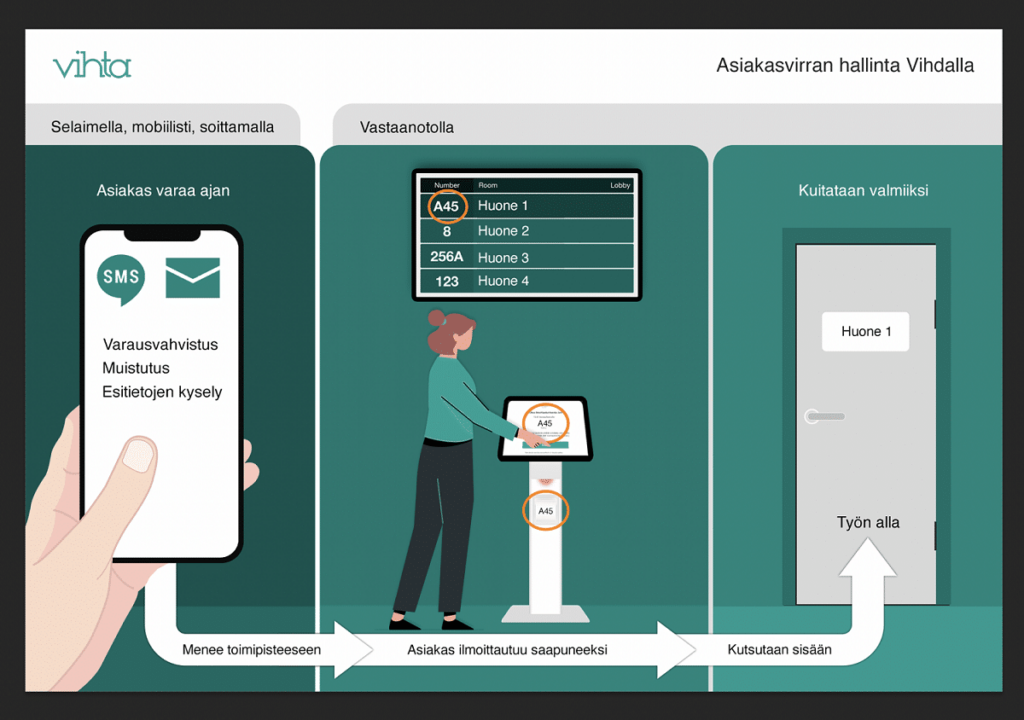
When a customer walks into a healthcare facility to receive a service, such as a doctor’s appointment or a lab test, the procedure traditionally begins by waiting for the appointment in the waiting room or registering in a queue with a customer service representative behind the desk. When their turn arrives, a professional comes to call the customer by name and asks them to follow them to the examination room.
Does this sound familiar?
Although this procedure is already simple, it may seem old-fashioned in terms of current practices and privacy protection.
Vihda’s self-registration system is an easy-to-use and automated customer guidance service developed for reception services that enables the customer to handle their registration independently, without the need for professionals to constantly walk between their room and the waiting room to inquire about arrivals.
This blog post explores how the self-registration system benefits both citizens’ service and healthcare professionals’ work in healthcare facility receptions.
It all starts with the customer booking an appointment for the required procedure through the booking service – Vihta appointment booking works on all web browsers and devices from computers to phones and tablets. After booking, the customer receives a confirmation message on their device and, if desired, a reminder message before the reception.
If the chosen healthcare facility uses Vihda’s self-registration system, the customer can register for the reception on Vihda’s automatic device upon arrival, which the professional sees on their device in their room. If the appointment has not been booked in advance, registration in the queue at the same automatic device on-site is also possible, meaning that the customer only needs to use one device during their visit to the reception. Self-registration can be done, for example, with a Kela or driver’s license or by manually entering the personal identification number.
The self-registration system has its own queues for both those who have booked appointments and those who have arrived without appointments, and the reception queue order is displayed as sequence numbers on the information screen belonging to the system.
In terms of privacy protection, customers are identified with the sequence numbers, which means that the receiving professional no longer needs to call customers by name to the reception. This way, customers’ anonymity is also preserved in the healthcare facility’s waiting area.
The customer benefits of the self-registration system are:
The self-check-in system is also visible at the professionals’ workstations. When a customer checks in at Vihda’s self-check-in kiosk, the professional sees on their own device which customers who have reserved appointments have already arrived and are waiting in the waiting area – allowing the professional to call in only those customers who have already arrived.
The professional no longer needs to run back and forth between the waiting area and the consultation room, wondering and calling out names, but can call the customer directly to their room with one click using the waiting area’s information screen.
In healthcare facilities, employees may use multiple systems simultaneously, and for example, appointment scheduling and queue management may be handled through different systems. The use of multiple software programs significantly slows down practical work.
In Vihda, employees see both customers with reserved appointments and those who arrived without reservations as separate queues on the same screen, eliminating the need to follow multiple systems. The professional has access to different buttons in their own service view to call in customers and mark events as tasks to do or completed.
If the facility is large and multiple employees use the same self-check-in system at the same time, everyone in the service view can follow the queue numbers and move customers to their own internal queues based on procedures. If multiple procedures are to be carried out at the same time, the customer can return to the waiting area after the first procedure, where they will be called to another appointment with the same number – management helps to avoid overlaps.
With Vihda’s self-check-in system, professionals can: